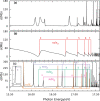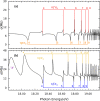Resonant Photoionization of CO2 up to the Fourth Ionization Threshold
- PMID: 38118433
- PMCID: PMC10788902
- DOI: 10.1021/acs.jpca.3c06947
Resonant Photoionization of CO2 up to the Fourth Ionization Threshold
Abstract
We present a comprehensive theoretical study of valence-shell photoionization of the CO2 molecule by using the XCHEM methodology. This method makes use of a fully correlated molecular electronic continuum at a level comparable to that provided by state-of-the-art quantum chemistry packages in bound-state calculations. The calculated total and angularly resolved photoionization cross sections are presented and discussed, with particular emphasis on the series of autoionizing resonances that appear between the first and the fourth ionization thresholds. Ten series of Rydberg autoionizing states are identified, including some not previously reported in the literature, and their energy positions and widths are provided. This is relevant in the context of ongoing experimental and theoretical efforts aimed at observing in real-time (attosecond time scale) the autoionization dynamics in molecules.
Conflict of interest statement
The authors declare no competing financial interest.
Figures









References
-
- Trabattoni A.; Klinker M.; González-Vázquez J.; Liu C.; Sansone G.; Linguerri R.; Hochlaf M.; Klei J.; Vrakking M. J. J.; Martín F.; et al. Mapping the Dissociative Ionization Dynamics of Molecular Nitrogen with Attosecond Time Resolution. Phys. Rev. X 2015, 5, 041053.10.1103/PhysRevX.5.041053. - DOI
LinkOut - more resources
Full Text Sources

